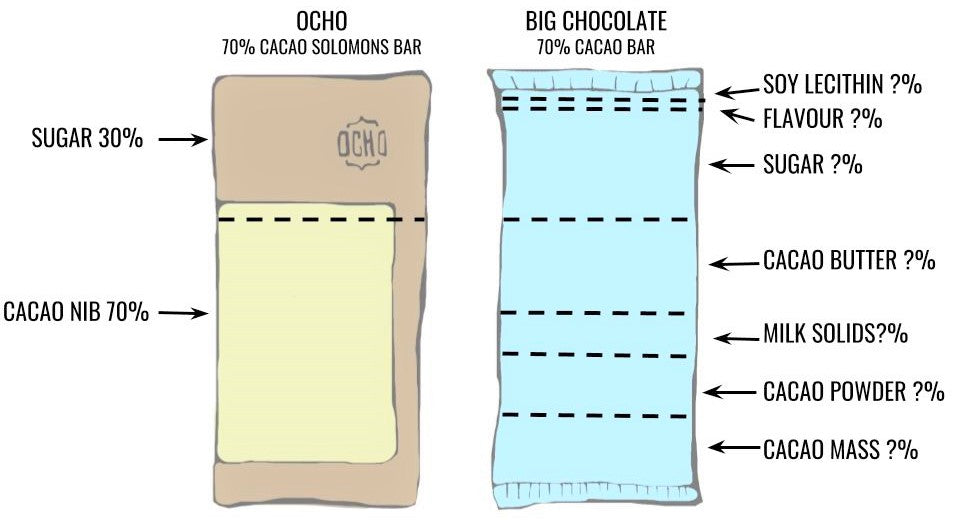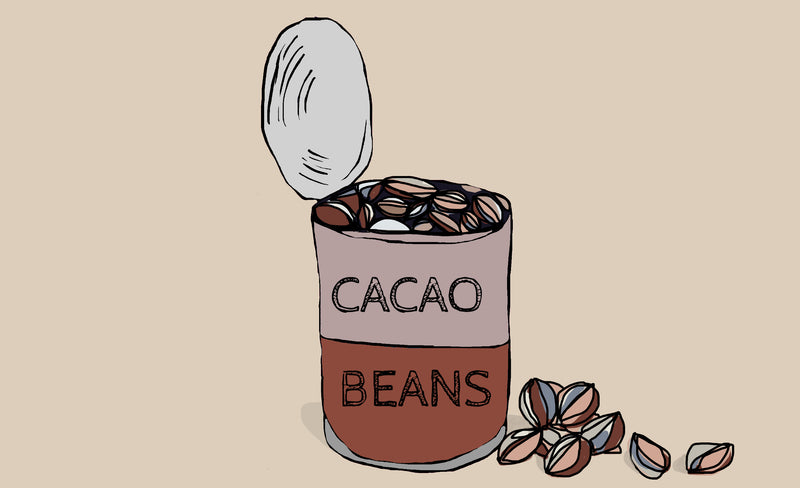Spilling the Beans - What’s really in chocolate?
Chocolate doesn’t have to be a complicated product and the way it’s made doesn’t have to be a secret. One of OCHO’s goals is to eliminate the mystery around chocolate by sharing what we know, from what goes in to our bars to how we make them. This article is the first in a Spilling the Beans series about chocolate.
Not so many years ago the ratio of cocoa to sugar in chocolate was a trade secret, cacao bean buying was done by men in suits hammering out the lowest price deals, and all chocolate was made in large, industrial-style factories. Things began to shake out in the mid 1990’s with the launch of Scharffen Berger, the first modern American bean-to-bar chocolate company. These guys figured out how to make small batch chocolate, and put cacao percentage and bean origin on their labels. The craft bean-to-bar chocolate movement was born.
The early makers of craft bean-to-bar chocolate had a lot to learn, after all, the big chocolate brands had been operating behind closed doors with the utmost secrecy. Makers had to teach themselves how to identify good beans, remove the husk and refine the chocolate without large scale equipment. Websites like John Nancie's Chocolate Alchemy were instrumental in sharing knowledge with people across the globe, and slowly more and more craft bean-to-bar makers started up. These days there is a wealth of information along with equipment and bean brokers so that anyone can get set up to make chocolate at home.
Real chocolate
So, what is the big deal about craft chocolate? Next time you’re heading down the chocolate aisle at the supermarket, check out what’s in the bars. Even a plain dark chocolate bar can have a long list of ingredients and different names can be used for the same thing. For example, cocoa mass is ground up cocoa nibs whereas cocoa powder and cocoa solids are both names for what’s left behind once cocoa butter is taken out of the beans. There will also be sugar, maybe cocoa butter, and likely some kind of flavouring. Most bars include an emulsifier like soy lecithin, and you might strike milk solids sometimes in dark chocolate. Remember that ingredient lists have to start with the biggest item first, so if the list starts with sugar then it means there’s more sugar than cocoa beans in the bar.
It does taste different
Every time you buy something from a big chocolate brand, you know exactly how it is going to taste. Vanilla is often added because it helps soften the chocolate and gives that familiar flavour many of us associate with chocolate from our childhood. An emulsifier helps achieve a smooth consistency and mouth feel, but is often soy based so causes problems for those intolerant to soy. Cocoa butter can be one of the trickiest ingredients to pin down. It’s in the beans originally, but is sometimes taken out and then added back in different quantities to help give the silky mouthfeel people associate with chocolate, especially quality European-made chocolate.

The cacao percentage of a bar can include added cocoa butter, but makers don’t have to put the exact split between cocoa nibs and cocoa butter. Using this ingredient can be a way of making a bar appear to have a higher ratio of cacao to sugar, but still a softer flavour. Really cheap chocolate, called compound chocolate, replaces cocoa butter with a cheaper fat like palm oil. This is usually used to make chocolate buttons or drops for baking.
Craft chocolate makers on the other hand generally take a less-is-more approach to ingredients and celebrate the difference in flavour between bars. Many only use two ingredients in dark chocolate bars - cacao nibs and sugar. In our 70% Cacao Solomons bar, 70 grams out of every 100 grams is cocoa nibs (cocoa beans minus the husk) and 30 grams is sugar. There is nothing else in the bar. The percentage of cacao is usually displayed prominently on the front of the packet, though this is not always the best indicator of how strong a bar will be because different beans have different flavour profiles.
Taking the lead
There’s no doubt that craft bean-to-bar chocolate is setting new standards for the chocolate industry. We are starting to see the big chocolate brands following in the craft makers’ footsteps by displaying the cacao ratio on the front of a packet and naming bars after the origin of the cocoa. The next article in the Spilling the Beans series will be on why chocolate bars taste different, even when they have the same ingredients, and defining what ‘origin’ really means.
Visit the OCHO Cafe & Shop to see chocolate making in action. Our little factory is roasting, grinding and tempering away, turning beans into chocolate bars at 22 Vogel St Dunedin, New Zealand.




